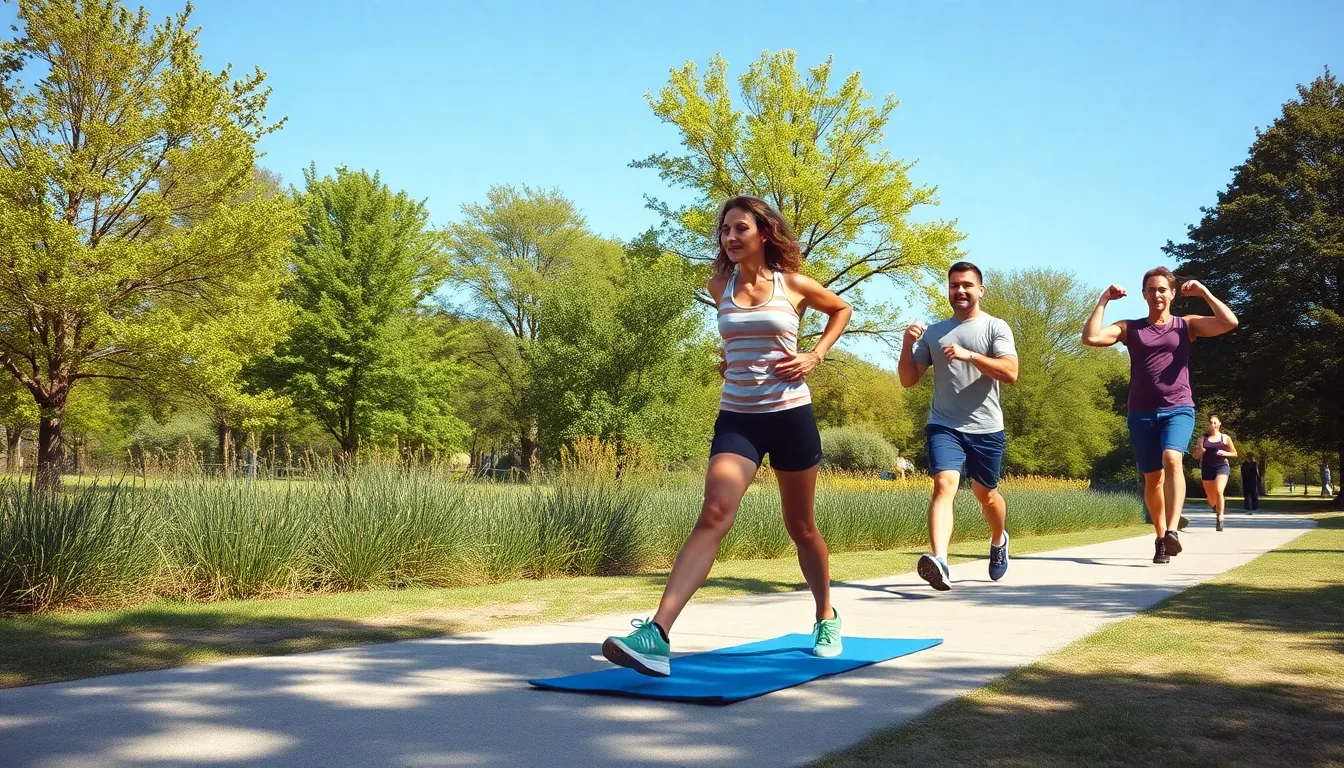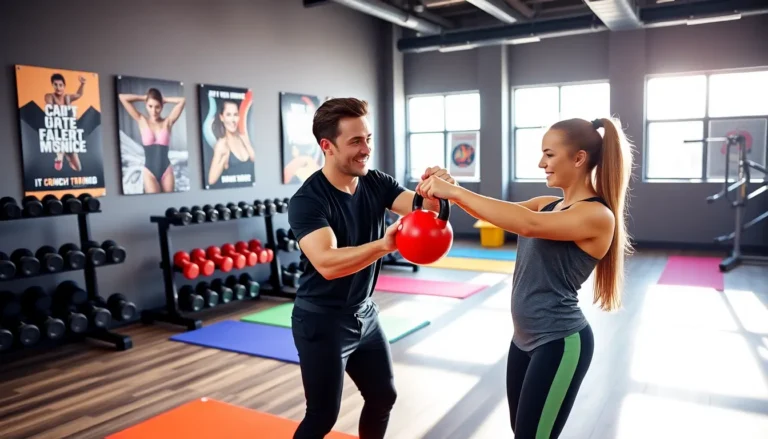Finding the right exercise routine can feel like searching for a needle in a haystack—or maybe a dumbbell in a gym bag. With countless options out there, it’s easy to get overwhelmed. But fear not! Whether you’re a seasoned gym rat or someone who thinks “squats” is a type of seating arrangement, there’s a perfect plan waiting for you.
Table of Contents
ToggleOverview Of Exercise Routines
Exercise routines consist of structured plans that organize physical activities to achieve fitness goals. Beginners often benefit from discovering simple routines that gradually build intensity. Experienced individuals may seek advanced programs to challenge their endurance or strength.
Strength training focuses on building muscle through resistance exercises, such as lifting weights. Cardiovascular workouts improve heart health and stamina through methods like running or cycling. Flexibility routines enhance range of motion with stretches and yoga practices.
Different routines target various fitness objectives. For weight loss, a combination of high-intensity interval training (HIIT) and weight lifting proves effective. Endurance athletes often prioritize long-distance running or cycling to enhance performance. Strength enthusiasts typically follow a regimen emphasizing powerlifting or bodybuilding techniques.
Incorporating variety keeps routines engaging and encourages consistent participation. Cross-training, which combines multiple exercise types, helps prevent injuries and boosts overall fitness. Scheduling workouts consistently leads to better results, with most experts recommending at least 150 minutes of moderate aerobic activity each week.
Accessible resources aid in designing exercise routines. Many fitness apps offer customizable plans suited for individual needs. Online platforms often provide video demonstrations for proper form and technique, ensuring effective workouts.
Overall, understanding exercise routines empowers individuals to choose plans that align with their fitness levels and goals. Prioritizing personal preferences and physical capabilities leads to a sustainable and enjoyable fitness journey.
Benefits Of Exercise Routines

Exercise routines offer numerous advantages that contribute significantly to overall well-being. These routines enhance both physical health and mental wellness.
Physical Health Benefits
Regular exercise routines lead to improved cardiovascular health. They promote weight management, reduce the risk of chronic diseases, and enhance musculoskeletal strength. Engaging in a consistent fitness plan improves flexibility and coordination, which supports overall mobility. Structured workouts can also elevate metabolic rates, enabling individuals to burn more calories even at rest. Studies indicate that those who exercise regularly enjoy enhanced immune function and lower blood pressure. Data shows that just 150 minutes of moderate aerobic activity each week can lead to substantial health improvements.
Mental Health Benefits
Incorporating exercise routines significantly impacts mental health. Physical activity stimulates the release of endorphins, which can elevate mood and reduce feelings of stress. Regular participation in structured workouts has been linked to lower levels of anxiety and depression. Engaging in exercise fosters better sleep patterns, aiding in relaxation and recovery. Furthermore, consistent routines build confidence and self-esteem as individuals progress toward their fitness goals. Research indicates that people who maintain an active lifestyle experience improved cognitive function and memory capabilities.
Types Of Exercise Routines
Exercise routines can be categorized into three main types: aerobic exercise, strength training, and flexibility and balance exercises. Each type serves a unique purpose in achieving overall fitness.
Aerobic Exercise
Aerobic exercises elevate heart rate and enhance cardiovascular health. Popular activities include running, cycling, swimming, and dancing. Many individuals enjoy group classes or solo workouts tailored to different fitness levels. Engaging in aerobic activities for at least 150 minutes each week promotes endurance and burns calories effectively. Consistent participation can lead to improved lung capacity and stamina, making everyday tasks easier and more enjoyable.
Strength Training
Strength training focuses on building muscular strength and endurance. Resistance exercises, free weights, and bodyweight workouts are common methods. Individuals can target specific muscle groups or adopt a full-body approach, depending on their goals. Incorporating strength training at least twice a week contributes to muscle growth, increases metabolism, and improves bone density. Adapting routines to suit personal preferences ensures continuous progress and motivation.
Flexibility and Balance Exercises
Flexibility and balance exercises enhance overall mobility and stability. Stretching, yoga, and Pilates provide significant benefits for muscle elasticity and joint function. Many individuals find these practices reduce the risk of injury and improve athletic performance. Performing flexibility and balance exercises regularly promotes relaxation and mental clarity, making them valuable additions to any fitness routine. Prioritizing these activities encourages a well-rounded approach to health and fitness.
Creating An Effective Exercise Routine
Creating an effective exercise routine involves several critical steps. Individuals should start by identifying specific fitness goals to tailor their routine accordingly.
Setting Goals
Setting realistic and measurable fitness goals serves as the foundation of any exercise plan. Goals can range from weight loss targets to improving strength or endurance. He or she might aim to lose five pounds in a month or run a 5K within three months. Making these goals specific provides clear milestones for tracking progress. Regularly revisiting these objectives helps maintain motivation and adjust routines as needed.
Choosing The Right Exercises
Choosing the right exercises ensures the routine aligns with individual goals and preferences. A blend of aerobic, strength, and flexibility workouts creates a well-rounded regimen. For example, someone focused on weight loss might incorporate high-intensity interval training and strength elements. Flexibility exercises, like yoga, can enhance recovery and overall mobility. Selecting enjoyable activities increases adherence, making it easier to stick with the routine.
Structuring Your Routine
Structuring the routine effectively maximizes benefits and enhances consistency. Experts recommend including a mix of aerobic, strength, and flexibility work throughout the week. Scheduling workouts at specific times can create a habit, while varying intensity levels keeps engagement high. For instance, dedicating three days to strength training, two days to cardio, and one day for flexibility exercises balances demands on the body. Individuals must also integrate rest days to allow adequate recovery and prevent burnout.
Finding the right exercise routine is a personal journey that requires exploration and adaptability. By understanding individual fitness levels and preferences, anyone can create a tailored plan that not only meets their goals but also keeps them engaged. Incorporating variety and consistency into workouts ensures long-term adherence and maximizes health benefits.
Ultimately, embracing a well-structured exercise routine can lead to significant improvements in physical and mental well-being. With the right approach and resources, individuals can transform their fitness journey into an enjoyable and rewarding experience.





